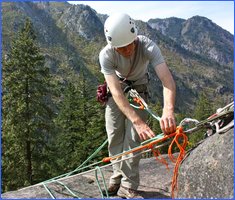Leavenworth Rock Guides: Improvised Rock Rescue Course
Rock rescue is one of the more commonly overlooked aspects of rock climbing. How do you escape the belay if your second is inured? What would you do if a lead climber was injured on a multi-pitch climb? These are very common concerns for rock climbers, but many climbers do not have a plan in place for a time when things go wrong. We routinely climb with very good climbers who don't have dialed systems for basic rock rescue skills such as escaping the belay, ascending fixed lines, and raising or lowering an injured climber. These drills represent the basic set of skills needed to raise, lower, or stabilize and injured climbing partner or to help other parties you might encounter in the course of climbing.
Topics covered include: escaping the belay, raises, lowers, ascending fixed line, 2:1, 3:1, 5:1, and 6:1 mechanical advantage systems, tandem rappels, pre-rigged rappels, reversible hitches, improvised chest harnesses, and a variety of other useful knots and hitches. This course usually takes a full day and one guide can generally teach this is to a large group of people. Participants should already be familiar with belaying, rappelling, and building anchors, and should know the following knots and hitches: figure eight, munter hitch, clove hitch, prussic hitch. If you are not familiar with these skills we can still run the program at a 1:1 ratio and get you up to speed.
Past participants have included recreational climbers, search and rescue personnel, and people entering AMGA courses that want to review the drills they will be tested in during their AMGA courses or exams. You do not need your own equipment for this program, but it makes sense to learn these skills with the equipment that you will be using when climbing on your own. When broken down into basic processes, most participants are surprised by how quickly they are able to build just the right system to overcome the problem at hand.
Itinerary
If run at a 1:1 ratio this program takes about 5 hours, and if run at a 2:1 or greater ratio the course takes 8 hours. Courses are scheduled on demand.Qualifications
Participants should be familiar with belaying, basic climbing knots, and should be able build a solid climbing anchor.Registration
To register for this course you should complete our domestic climbing application and return it to the Northwest Mountain School office. You can complete our online registration here. Once you have completed your application you can make your deposit or full payment here. It is best to call our office at 509-548-5823 to make sure that space is available on your selected program. Space is allotted on a first-come, first-serve basis.





